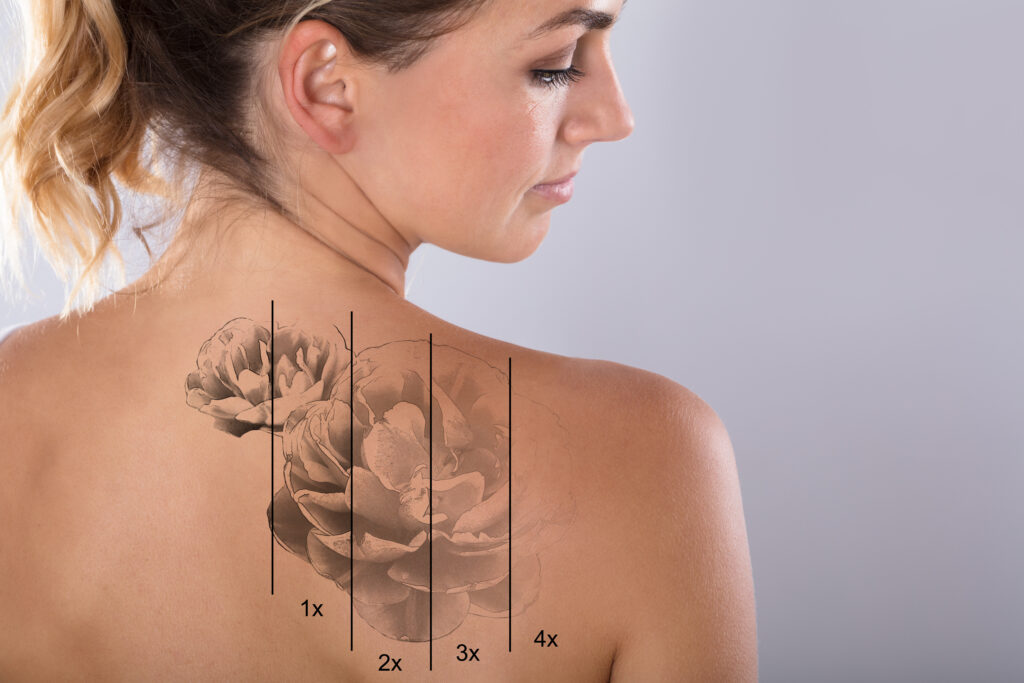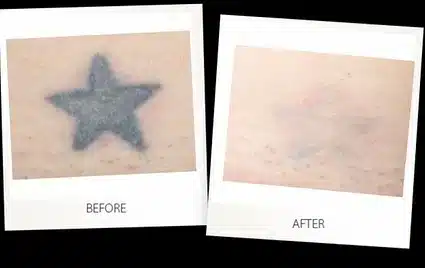Laser tattoo removal is a medical procedure that uses concentrated light energy to break down the ink particles in a tattoo. Over time, these particles are gradually absorbed and eliminated by the body’s immune system. This method is the most effective and widely used approach for removing tattoos, and it has become the gold standard in tattoo removal treatments.
The process relies on the principle of selective photothermolysis, where specific wavelengths of light are absorbed by the tattoo ink. Each color of ink absorbs different wavelengths, which is why various types of lasers are used based on the colors of the tattoo. The light energy from the laser is absorbed by the pigment particles in the ink, causing them to fragment into smaller particles that can be cleared away by the body’s immune system.
Before the treatment, you will need to be seen for a consultation with our trained laser technician who will evaluate the tattoo, skin type, and medical history to determine the most appropriate treatment. The technician will explain the process, risks, and expected outcomes, and may take photographs for reference. The technician uses a laser device to target the tattooed area. The laser delivers short, quick bursts of light energy that break down the ink. The treatment typically lasts anywhere from a few minutes to half an hour, depending on the size and complexity of the tattoo. The sensation felt during the procedure is often described as a rubber band snapping against the skin, though pain tolerance varies from person to person.
Laser tattoo removal is a highly effective treatment, but it may not be suitable for everyone. The best candidates for tattoo removal are generally in good health, have realistic expectations, and are not prone to keloid scarring or other skin conditions that could complicate healing.

Laser tattoo removal can significantly fade or completely remove tattoos, but results can vary from person to person. Black and dark blue tattoos are the easiest to treat, while lighter colors like yellow and green are more difficult to remove.

Tattoo removal is a gradual process, and the number of sessions required can vary depending on various factors such as: Tattoo Size: Larger tattoos generally require more sessions, Ink Color: Darker colors (such as black) are easier to treat, while lighter colors (like yellow or white) may require more sessions, Ink Depth: Tattoos with deeper ink penetration may require more treatments than those closer to the surface, Skin Type: People with darker skin tones may require specialized lasers for safe and effective treatment, Tattoo Age: Older tattoos are often easier to remove than newer ones because the ink has already begun to break down naturally. On average, 6 to 12 sessions spaced 6 to 10 weeks apart are typically required to achieve optimal results. However, some tattoos may require more treatments, especially if they are multi-colored, have dense ink, or are located on challenging areas of the body.

The skin may be cleaned, and sometimes, a topical numbing cream or local anesthesia is applied to reduce discomfort. The tattooed area may be shaved if necessary to ensure the laser can access the skin directly. After the procedure, the treated area may appear red, swollen, or bruised, similar to a sunburn. Some blisters or scabs may form as the body heals. The treated area should be kept clean and moisturized, and it is important to avoid picking at scabs or blisters to prevent scarring. Sunscreen should be applied regularly to the treated area to protect the skin from UV exposure.
The cost of laser tattoo removal depends on various factors, including the size of the tattoo and the number of sessions required.
Harmony XL Pro
© 2025 The Beauty Loft Med Spa | All Rights Reserved | Powered By Consumr Buzz